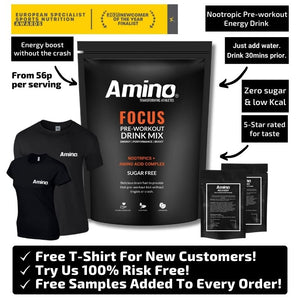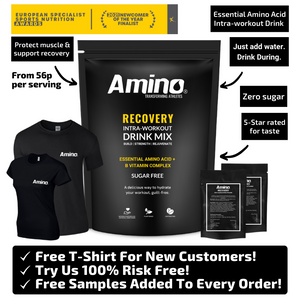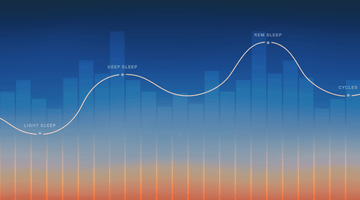What are amino acids?
Amino acids are known as the ‘building blocks’ of protein and muscle tissue. There are 21 amino acids that our bodies are made from. Each amino acid has a crucial role and function in the body and they are involved in most physiological processes relating to activity, energy, recovery, muscle strength gains and fat loss, as well as mood and brain function.
Amino Acid Basics
Amino acids are grouped into three categories – Essential, Nonessential, and Conditional. The group to which a specific amino acid belongs depends on where your body obtains it. [1]
- Essential Amino Acids: Also referred to in sports nutrition with the acronym EAAs. Your body cannot produce or store essential amino acids. These must be obtained by an external source every day, usually through food or supplementation.
There are 9 essential amino acids, which are:
- Leucine (BCAA)
- Isoleucine (BCAA)
- Valine (BCAA)
- Histidine
- Lysine
- Methionine
- Phenylalanine
- Threonine
- Tryptophan
Branched-chain amino acids. BCAAs are actually a “subcategory” of EAA. Leucine, Valine and Isoleucine are all essential amino acids. These three amino acids, although essential, are primarily referred to as BCAAs because of their “branched-chain” molecular structure which is distinctly different from the other 6 essential amino acids.
- Non-essential amino acids: Non-essential amino acids are those which your body naturally produces throughout the day whether or not you eat food that contains them. The non-essential amino acids are:
- Alanine
- Asparagine
- Aspartic acid
- Glutamic acid
- Conditional amino acids: A relatively new classification. These amino acids are produced only under specific circumstances, typically when your body is fighting off an illness or dealing with stress. These conditional amino acids are:
- Arginine
- Cysteine
- Glutamine
- Tyrosine
- Glycine
- Ornithine
- Proline
- Serine
Who can benefit from amino acids?
The short answer is everyone. We all need amino acids. Amino acids have a role in almost every part of your body, [2] including:
- Assisting in the creation and growth of muscles, connective tissue, and skin
- Assisting in maintaining muscle tone and tissue strength
- Healing and repair
- Normal digestion
- Providing energy for your body
- Regulating moods by helping produce hormones
- Producing neurotransmitters
- Maintaining healthy skin, hair and nails
Through a balanced diet, most people are able to get a healthy intake of essential and non-essential amino acids throughout their day. Without an adequate intake of amino acids, your body will not be able to produce proteins in your body as effectively and, in some cases, the proteins in muscle and tissues will start to weaken or degrade.
Myth: Amino Acids are just for athletes and bodybuilders
Yes, athletes and bodybuilders for decades have looked to amino acids to boost performance, maintain muscle strength and support recovery for their next training session. However, there are numerous other ways amino acids can help other active individuals think, feel and perform better [3], such as:
- Modifying the way the body perceives fatigue and prolonging how long individuals can perform before fatigue sets in.
- Enhancing how your body metabolizes fats during exercise.
- Decreasing the duration of recovery from overtraining.
- Increasing tolerance to pain during exercise so that individuals can push themselves further.
- Improving immune function for less frequency of illness or infection.
- Improving performance in aerobic training.
- Supporting blood flow for improved endurance.
- Improving the development of lean muscle mass and overall strength.
- Improving antioxidant production to reduce cellular damage.
- Providing anti-inflammatory and anti-oxidative effects to reduce damage to muscles.
- Helping prevent muscle wasting (in conjunction with resistance training).
Fact: Did you know amino acids can reduce natural muscle loss in ageing individuals?
How are amino acids best obtained?
The most common ways to ensure you get enough amino acids every day is through food or supplementation with protein powders or amino acid powder, tablets and drinks.
Amino acids can be easily found in both animal and plant products, quality lean meats, dairy products, vegetables and legumes. Although some food items may contain only part of the amino acids you need. For example, some foods may contain only essential amino acids; others may contain all of them; others still may only contain non-essential types. You do not need to eat essential and non-essential amino acids at every meal, but getting a balance of them over the whole day is important to ensure that you are getting all of the amino acids that you need to feel your best.
Some people – especially athletes the elderly and individuals who push their bodies to the limit or have restrictive diets– may need to more carefully consider how and when they get the amino acids they need. [5]
Advances in sports nutrition technology now mean we’re not limited to traditional supplements that contain dietary proteins. We now can isolate each of the individual amino acids and use them free-form (already broken down so no digestion required) so they can get straight to work where they are needed. This allows us to create products that have the optimal combinations that target specific health goals for physically active individuals. [6]
Do I need to supplement with amino acids?
Choosing to supplement with amino acids will depend on your specific situation and your health and fitness goals.
Amino acids are not stored by the body, so regardless of their source, food or supplements, your body will essentially use the amount it needs at the time it is needed and get rid of the rest through your urine.
For the body to be able to use amino acids they need to be readily available when they are needed, which means they have been digested, absorbed and bio-available.
So for athletes and active individuals looking to benefit from amino acids for athletic performance, the right nutrients need to be available in and around the point your body and muscles are undergoing stress.
Food needs to be digested before amino acids are available for your body to use. Therefore, eating regular food before, during and after an intense effort would a way to ensure your body has enough amino acids available at the time it needs it. However, eating in this way may not be practical nor arguably as effective even if the basic nutritional components for muscle healing are available in the meals consumed. Also, preparing balanced meals in and around your workouts can take the time you may not have.
Eating a healthy balanced diet of whole foods should remain the foundation of any nutrition programme. However, when you’re looking to get more from your body and are pushing it to the limit as we do during exercise, amino acids supplements can then be used alongside your training as a targeted delivery mechanism to help you achieve better results. [7]
How quickly do amino acids work?
Timing can play an important role when it comes to deciding how and when it's best to obtain the amino acids your body needs. As we mentioned above, amino acids are not stored. Therefore, the speed at which they become readily available is also largely dependent on or can be limited by the source.
Not all sources are equal in terms of accessibility, digestibility or quality. Complete proteins do not break down into their amino acids fully or at the rate of hydrolyzed protein or free form amino acids. [8] And not everyone digests at the same speed, particular as we age. [9] Plus amino acids are also used all over the body so not 100% of the amino acids we consume will be used in your targeted area of interest.
That aside, the below will give you a rough idea of how quickly the amino acids from certain sources might be readily available in the average person. [10]
High protein food digestion:
- Fish, Eggs - 30-60 mins
- Chicken (without skin) - 1.5-2 hours
- Soybeans, Peas, Kidney beans - 1.5-2 hours
- Seeds, Nuts - 2-3 hours
- Beef, lamb - 2.5-4 hours
- (Hard) Cheese - 4-5 hours
- Pork - 4.5-5 hours
Protein shakes digestion:
- Fast digesting protein - 1-2.5 hours
This is usually a form of whey with standard whey concentrate being the slowest (2-2.5 hours), whey isolates slightly faster and whey hydrolysate being the fastest and can be digested within 1-1.5 hours.
- Medium digesting protein - 3-3.5 hours
There are a number of proteins in this range such as whole egg protein, egg white protein, pea protein and rice/soy protein.
- Slow digesting protein - 4 hours +/-
Casein is typically the one protein that is used in this case in its various forms
Amino acids supplements digestion:
Amino acids supplements are generally consumed in ready to mix powders or tablets/capsules. And there are 2 main types of amino acids found in these nutrition products which are peptide bonded amino acids and free-form amino acids.
- Free-form amino acids (like those we use at Amino) refer to single amino acids that are already in a pre-digested form and ready to be used by your body within 15 mins. [15] So for faster utilization and better bioavailability, look for free-form amino acids.
- Peptide bonded amino acids are slower to become available. Larger peptides (chains of amino acids) must first be digested into smaller peptides and individual amino acids before use.
Also bear in mind that tablets and capsules also need digesting before the amino acids are released and therefore take a little longer to disperse. If you need a quick fix, opt for the powdered versions.
Where do amino acid supplements come from?
There are several ways to manufacture amino acids. Common sources include animal proteins, and/or plant-based proteins. [11]
In terms of animal-sourced amino acids, these can be extracted from proteins such as whey (a by-product of cheese making). However, they are often derived from waste products such as hair, wool, nails, feathers etc, which all contain a protein called keratin. These waste products are then processed using toxic chemicals that break apart the proteins and eventually extract the constituent amino acids which are then sold as amino acid supplements.
Plant-based amino acids are produced through the fermentation of a carbohydrate source such as glucose, corn or cane sugar which is then fed to friendly probiotic bacteria. Depending upon the probiotic strain and the source of the carbohydrate, these bacteria produce specific amino acids. The amino acids are then collected, purified and prepared as a powder which is then available for use in dietary supplements.
At Amino we insist on using premium vegan-friendly plant-based fermented amino acids in our products. Not only does this yield a cleaner and superior chemical-free product, but it also gives you peace of mind that you are not ingesting amino acids from some old duck feathers.
Amino acid supplementation and exercise
Amino acids supplements, like the products we create at Amino, are becoming more and more popular with a growing interest in how these amazing nutrients can be used to benefit our health.
Traditionally this interest has focused on the ability for amino acids to support protein synthesis. And for decades athletes, bodybuilders and active individuals have relied on essential amino acids packed nutrition to get the results they’re looking for. This is why you’ll typically see the nutrition product market dominated mainly by the Essential Amino Acids (EAAs) and the slightly more well-known essential amino acids, BCAAs.
Should I be taking amino acids when I workout?
As with most things, deciding whether to supplement or not, depends on the person. Always start by looking at the nutrient density of your diet and when and how you eat throughout the day. Then, how intensely you stay active and work out? And do you have a particular fitness goal in mind?
Generally speaking, we see 4 types of individuals that might benefit from using full-spectrum essential amino acid (EAA) supplements in and around their work out.
Those looking for:
- Muscle - if you’re looking to build muscle, EAAs can be used alongside a calorie excess diet strategy to enhance or increase muscle mass.
- Fat loss - in order to preserve muscle mass when cutting body fat. As EAAs will spare muscle tissue when in a calories deficit which is hugely important so you preserve what you have. If you burn away your muscle mass you decrease the size of the engine which will, in turn, make fat burning harder.
- Performance - for sportspeople looking to improve their performance and recover quicker for their next training session which ultimately supports an objective outcome.
- Active ageing - older gym-goers and athletes as due to decreased protein digestion efficiency amino acids are a reliable alternative.
Which should you take, EAAs or BCAAs?
EAAs vs BCAAs (branched-chain amino acids) can be a bit of a controversial topic. Some claim BCAAs are a complete waste of money, some swear by them – some prefer EAAs.
However, little do they know, BCAAs are EAAs.
3 out of the 9 essential amino acids are known as BCAAs (Leucine, Isoleucine, and Valine).
BCAAs can be used on their own to great effect; they function in a way that helps protect muscle tissue. BCAAs are also proven to kick-start muscle protein synthesis (MPS), with Leucine being the crucial essential amino acid for triggering the pathways for this process. [12]
Nevertheless, recent research shows that actual muscle protein synthesis can only take place when all 9 of the essential amino acids are present. Leucine essentially opens the door but needs its other teammates to complete the job. So this is the basis of the claim that BCAAs on their own are pointless. [13]
BCAAs work best when used in conjunction with the other EAAs, as they work together to create new muscle proteins. However, whether the EAAs are present through an EAA rich pre-workout meal or you take a full EAA spectrum supplement - it comes down to personal preference and practicality.
In short, it’s best to take the food first approach. It is possible to receive all of your essential amino acids, through a well-balanced diet that is planned and optimized to suit your training and athletic goals. However, not everyone can or wants to eat a bowl of chicken and broccoli in and around their training sessions, hence supplementing with a quality EAA supplement can be a lighter and more practical choice.
Also, people that have restrictive diets, or those with plant-based diets, will benefit more from consuming a supplement to replenish and ensure optimal essential amino acid levels to promote new muscle growth and repair.
Fact: Did you know that amino acid breakdown requires B-vitamins?
When should I take essential amino acids (EAA) supplements?
For optimal results, it’s important to carefully time when you consume EAAs. [5, 15] Usually, the best time to take amino acids (both BCAA’s and EAA’s) is as an intra-workout (during your workout) supplement, however, this is not always practical depending on your training and the form of the supplement.
Essentially your goal is to ensure your body is positively flooded with essential amino acids during the time your body and muscle tissues are under the most stress. Remember when you train you’re damaging your tissues and energy systems so that with recovery and rest they will grow back stronger helping you perform.
Free-form amino acids like those in Amino are pre-digested, so they quickly pass through the stomach and enter into the bloodstream where they are rapidly delivered straight into your muscles cells. Therefore amino acid supplements can peak blood levels within 15-30 minutes.[15] However as fast as blood levels can peak, they can also decline. This is why it is important to consider continuously sipping on them during training to maintain a steady and constant supply.
Why do some amino acid supplements leave a chalky powdery residue?
In chemistry, amino acids are known as being hydrophobic. Simply put this means that amino acids repel water, which means that they remain largely insoluble in water.
Fortunately, technological advancements in manufacturing processes have enabled amino acids supplements to evolve and are now far more water-soluble. This is why the fermented plant-based amino acids in Amino products dissolve surprisingly easily and ensure maximum absorption.
Can I take amino acids supplements instead of proteins?
We would definitely not recommend this. Whilst there are countless benefits to taking amino acid supplements, amino acids are not complete structures like proteins are. Amino acids should not be used in place of protein.
Even if you supplemented with all 9 essential amino acids, you could not properly replace a first-class protein source and it could result in nutrient deficiencies. Protein foods provide other nutrients for athletic performance and health such as carnosine, carnitine, glutamine creatine and the B-Vitamins. The process of chewing food also has influences on hormones especially those that reduce hunger and help you feel full.
Both food protein and supplements have their function and both are different – use them accordingly to get maximum benefit.
References:
[1] What are amino acids? https://medlineplus.gov/ency/article/002222.htm
[2] The function of amino acids.
- Wu G. (2013). Functional amino acids in nutrition and health. Amino acids, 45(3), 407–411.
- https://www.healthline.com/nutrition/essential-amino-acids#benefits-of-supplements
- Lupton, J. R., Brooks, J. A., Butte, N. F., Caballero, B., Flatt, J. P., & Fried, S. K. (2002). Dietary reference intakes for energy, carbohydrate, fiber, fat, fatty acids, cholesterol, protein, and amino acids. National Academy Press: Washington, DC, USA, 5, 589-768.
[3] The ways in which amino acids can support and boost athletic performance.
- Williams M. (2005). Dietary supplements and sports performance: amino acids. Journal of the International Society of Sports Nutrition, 2(2), 63–67.
- Ra, S. G., Miyazaki, T., Ishikura, K., et al. (2013). Combined effect of branched-chain amino acids and taurine supplementation on delayed onset muscle soreness and muscle damage in high-intensity eccentric exercise. Journal of the International Society of Sports Nutrition, 10(1), 51.
- Walker, D. K., Dickinson, J. M., et al. (2011). Exercise, amino acids, and aging in the control of human muscle protein synthesis. Medicine and science in sports and exercise, 43(12), 2249–2258.
- Gualano AB, Bozza T, Lopes De Campos P, et al. (2011). Branched-chain amino acids supplementation enhances exercise capacity and lipid oxidation during endurance exercise after muscle glycogen depletion. The Journal of sports medicine and physical fitness, 51(1), 82–88.
[4] Amino acid supplementation can help the elderly.
- Børsheim, E., Bui, Q. U., Tissier, S., Kobayashi, H., Ferrando, A. A., & Wolfe, R. R. (2008). Effect of amino acid supplementation on muscle mass, strength and physical function in elderly. Clinical nutrition (Edinburgh, Scotland), 27(2), 189–195.
- Fujita, S., & Volpi, E. (2006). Amino acids and muscle loss with aging. The Journal of nutrition, 136(1 Suppl), 277S–80S.
[5] The latest exercise and sports nutrition recommendations
- Kerksick, C. M., Wilborn, C. D., Roberts, M. D., et al. (2018). ISSN exercise & sports nutrition review update: Research & recommendations. Journal of the International Society of Sports Nutrition, 15(1).
[6] Uses and functions of proteins and amino acids for athletes.
- Di Pasquale, M. G. (2007). Amino acids and proteins for the athlete: The anabolic edge. CRC Press.
[8] Amino acids in free-form or hydrolysate absorb faster than complete proteins.
- Koopman, Rene & Crombach, Nico & Gijsen, et al. (2009). Ingestion of a protein hydrolysate is accompanied by an accelerated in vivo digestion and absorption rate when compared with its intact protein. The American journal of clinical nutrition. 90. 106-15.
[9] Oral supplement absorption rates vary from person to person due to factors such as circulatory systems, gastric emptying time, and individual metabolic function.
- Huang, W., Lee, S. L., & Yu, L. X. (2009). Mechanistic approaches to predicting oral drug absorption. The AAPS journal, 11(2), 217–224.
[10] Handy guide answers the most common sports nutrition questions.
- Mizera, J., & Mizera, K. (2019). Sports Nutrition Handbook: Eat Smart. Be Healthy. Get On Top of Your Game. VeloPress.
[11] The manufacturer of amino acids.
- Huang, J., Nkrumah, P. N., Appiah-Sefah, G., & Tang, S. (2013). Authentication of pure L-leucine products manufactured in China by discriminating between plant and animal sources using nitrogen stable isotope technique. Journal of food science, 78(3), H490–H494.
[12] Leucine’s importance in triggering muscle protein synthesis.
- Pasiakos, S.M., McClung, H.L., McClung, J.P., et al. (2011). Leucine-enriched essential amino acid supplementation during moderate steady state exercise enhances postexercise muscle protein synthesis. The American Journal of Clinical Nutrition, 94(3), 809–818.
- Matsui, Y., Takayanagi, S., Ohira, T., et al. (2019). Effect of a leucine-enriched essential amino acids mixture on muscle recovery. Journal of Physical Therapy Science, 31(1), 95–101.
[13] BCAA supplements alone do not promote muscle anabolism. The availability of the other EAAs will rapidly become rate-limiting for accelerated protein synthesis.
- Wolfe R. R. (2017). Branched-chain amino acids and muscle protein synthesis in humans: myth or reality?. Journal of the International Society of Sports Nutrition, 14, 30.
[14] The breakdown of amino acids depletes B-Vitamin levels
- Audhya, T. (2012). ROLE OF B VITAMINS IN BIOLOGICAL METHYLATION. Health Diagnostics and Research Institute.
[15] The importance of timing in sports nutrition.






